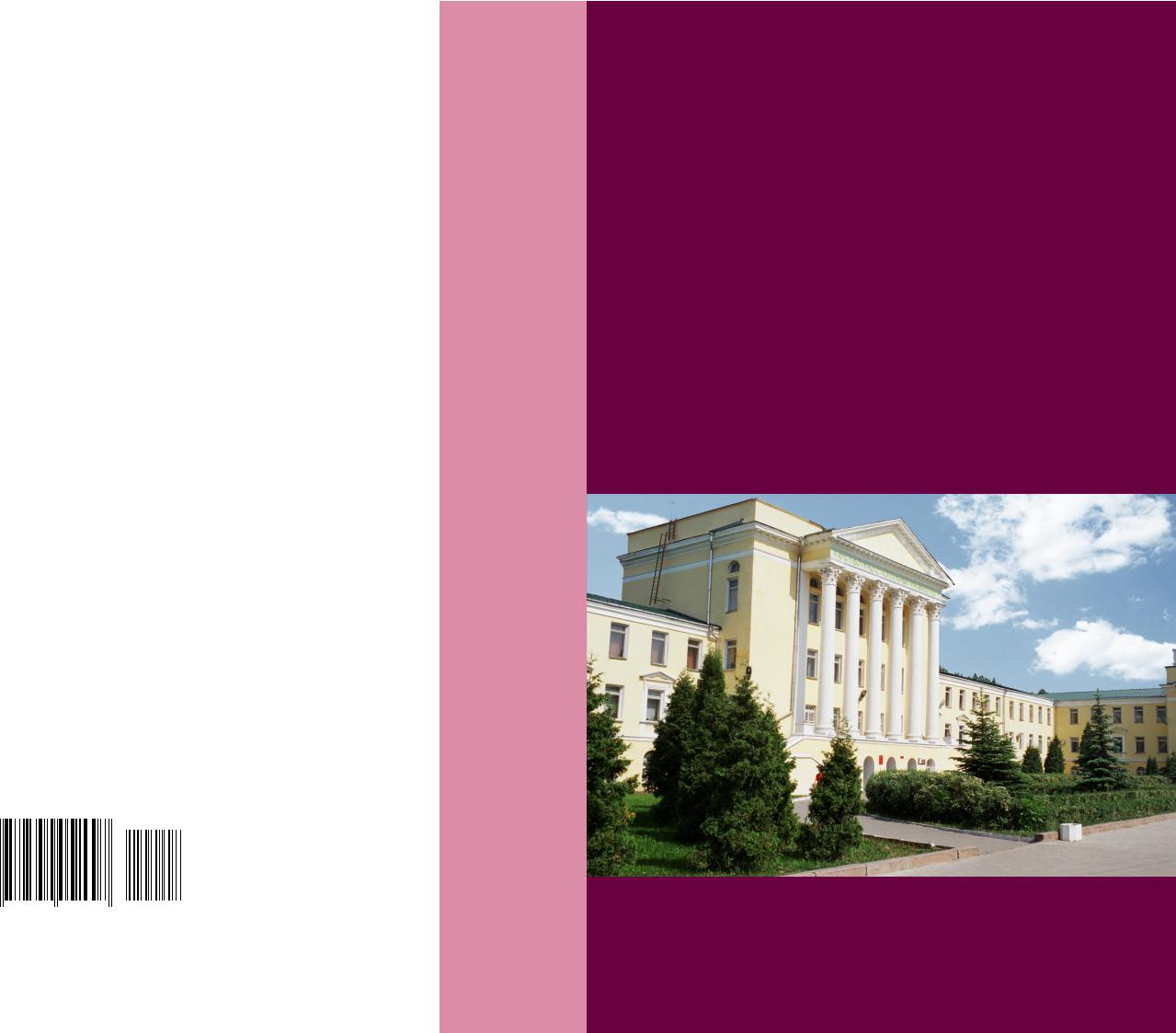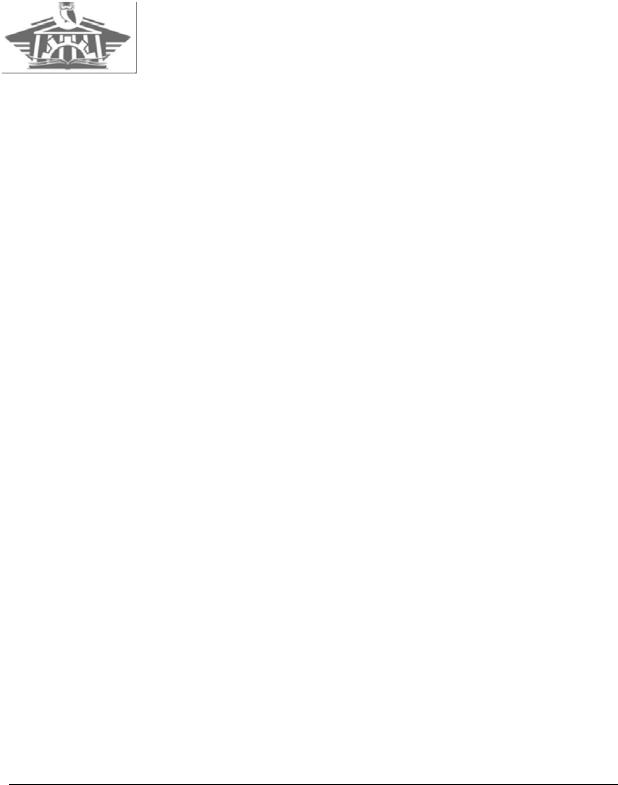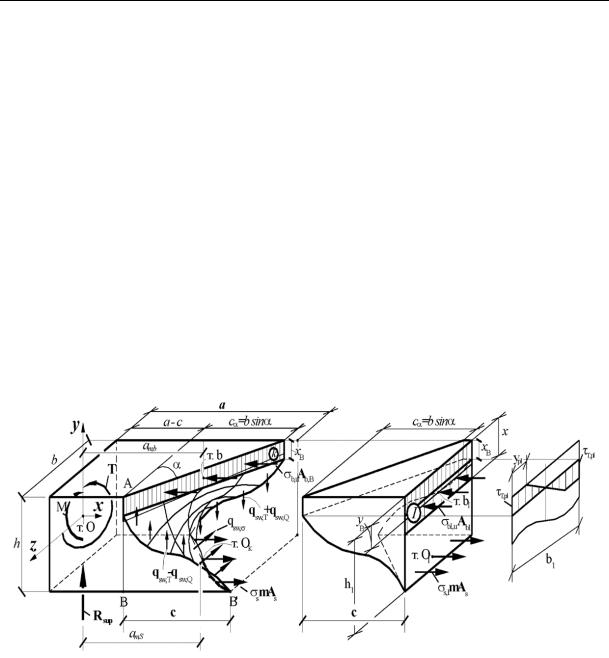
Russian Journal of Building Construction and Architecture
.pdf
ISSN 2542-0526
Russian Journal
of Building Construction
and Architecture
ISSN 2542-0526
9 772542 052007 |
2 0 0 4 7 |
Issue ¹ 3 (47), 2020
RUSSIAN JOURNAL
OF BUILDING
CONSTRUCTION AND ARCHITECTURE

The journal is indexed/abstracted in:
Web of Science Core Collection
(Emerging Sources Citation Index)
(Thomson Reuters), USA
Ulrich's Periodicals Directory
(Bowker), USA
DOAJ
(Lund University), Sweden
Academic Search Complete
(EBSCO), USA
SOCOLAR
(China Educational Publications Import and Export Corporation –– CEPIEC), China
Google Scholar
(Google), USA
E-Library
(ООО «РУНЭБ»), Russia
J-Gate
(Informatics Ltd), India
ISSN 2542-0526
RUSSIAN JOURNAL
OF BUILDING CONSTRUCTION
AND ARCHITECTURE
N 3 (47)
•BUILDING STRUCTURES, BUILDINGS AND CONSTRUCTIONS
•BASES AND FOUNDATIONS, UNDERGROUND STRUCTURES
•HEAT AND GAS SUPPLY, VENTILATION, AIR CONDITIONING, GAS SUPPLY AND ILLUMINATION
•BUILDING MATERIALS AND PRODUCTS
•TECHNOLOGY AND ORGANIZATION OF CONSTRUCTION
•DESIGNING AND CONSTRUCTION OF ROADS, SUBWAYS, AIRFIELDS, BRIDGES AND TRANSPORT TUNNELS
•BUILDING MECHANICS
•THEORY AND HISTORY OF ARCHITECTURE, RESTORATION AND RECONSTRUCTION OF HISTORICAL
AND ARCHITECTURAL HERITAGE
•ARCHITECTURE OF BUILDINGS AND STRUCTURES. CREATIVE CONCEPTIONS OF ARCHITECTURAL ACTIVITY
•CITY PLANNING, PLANNING OF VILLAGE SETTLEMENTS
Voronezh 2020

Russian Journal
of Building Construction and Architecture
Periodical scientific edition
Published since 2009 |
Comes out 4 times per annum |
|
|
|
|
Founder and publisher: Voronezh State Technical University.
The territory of distribution — Russian Federation.
The articles are reviewed and processed with the program ANTIPLAGIARISM. This publication cannot be reprinted without the prior permission of the publisher, references are obligatory.
Previous name: «Scientific Herald of the Voronezh State University of Architecture and Civil Engineering. Construction and Architecture».
EDITORIAL BOARD
Editor-in-Chief: Melkumov V. N., D. Sc. in Engineering, Prof.,
Voronezh State Technical University
Boldyrev А.М., Corresponding Member of the Russian Academy of Architecture and Engineering Science, D.Sc. in Engineering, Prof., Voronezh State Technical University, Russia
Bondarev B. А., D. Sc. in Engineering, Prof., Lipetsk State Technical University, Russia
Gagarin V. G., Corresponding Member of RAABS, Moscow State University of Civil Engineering, Russia
Gelfond А. L., Corresponding Member of the Russian Academy of Architecture and Construction Science, D. Sc. in Architecture, Nizhniy Novgorod State University of Architecture and Construction, Russia
Enin A. Ye., PhD in Architecture, Prof., Voronezh State Technical University, Russia
Karpenko N. I., Academician of RAABS, Research Institute of Building Physics (NIISF RAABS), Russia
Kirsanov М.N., D.Sc. in Physics and Mathematics, Professor (National Research University “Moscow Power
Engineering Institute”)
Kobelev N. S., D. Sc. in Engineering, Prof., Southwest State University, Kursk, Russia
Kolchunov V. I., Academician of RAABS, Southwest State University, Kursk, Russia
Ledenyev V. I., D. Sc. in Engineering, Prof., Tambov State Technical University, Russia
Lyahovich L. S., Academician of RAABS, Tomsk State University of Architecture and Building, Russia
Osipova N.N., D. Sc. in Engineering, Yury Gagarin Saratov State Technical University, Russia
Mailyan L. R., D. Sc. in Engineering, Prof., Don State Technical University, Rostov, Russia
Panibratov Yu. P., Academician of RAABS, Saint Petersburg State University of Architecture and Civil Engineering, Russia
Podolsky Vl. P., D. Sc. in Engineering, Prof., Voronezh State Technical University, Russia (Dep. of the Editor-in-Chief)
Slavinskaya G.V., D. Sc. in Chemistry, Prof, Voronezh State Technical University, Russia
Suleymanov А. М., D. Sc. in Engineering, Prof., Kazan State University of Architecture and Engineering, Russia
Fyedorov V. S., Academician of RAABS, Moscow State University of Railway Engineering, Russia
Fedosov S. V., Academician of RAABS, Moscow State University of Civil Engineering, Russia
Chernyshov Ye. M., Academician of RAABS, Voronezh State Technical University, Russia
Shapiro D. M., D. Sc. in Engineering, Prof., Voronezh State Technical University, Russia
Shubenkov М. V., Academician of the Russian Academy of Architecture and Construction Science, D. Sc. in Architecture, Prof., Моscow Institute of Architecture (State Academy), Russia Asanowicz Alexander, Prof., Dr. of Sn., Technical University of Bialystok, Poland
Figovsky Oleg L., Prof., Dr. of Sn., Member of EAS, Israel Korsun V. I., D. Sc. in Engineering, Prof., The Donbas National Academy of Civil Engineering and Architecture, Ukraine
Nguyen Van Thinh, Prof., Dr. of Sn., Hanoi University of Architecture, Vietnam
Editor: Kotlyarova E. S. Translator: Litvinova O. A. Executive secretary: Mikhnevich I.V.
Publication date 23.11.2020. Format 60×84 1/8. Conventional printed sheets 10,7. Circulation 500 copies. Order 185. Number of the certificate of registration of the media ПИ № ФС 77-67855
Issued by the Federal Service for Supervision of Communications, Information Technology, and Mass Media (Roskomnadzor)
Price is subject to change
THE ADDRESS of EDITORIAL AND THE PUBLISHER OFFICE:
room 2230, 84 20-letiya Oktyabrya str., Voronezh, 394006, Russian Federation Tel./fax: (473)2-774-006; e-mail: vestnik_vgasu@mail.ru
Published in Printing Office of Voronezh State Technical University 84 20-letiya Oktyabrya str., Voronezh, 394006, Russian Federation
© Voronezh State Technical University, 2020
Issue № 3 (47), 2020 |
ISSN 2542-0526 |
|
|
|
|
CONTENTS |
|
BUILDING STRUCTURES, BUILDINGS AND CONSTRUCTIONS ................................................... |
6 |
Fedorov V. S., Kolchunov Vl. I., Pokusaev A. A., Naumov N. V. |
|
Calculation Models of Deformation of Reinforced Concrete Constructions |
|
with Spatial Cracks..................................................................................................................... |
6 |
HEAT AND GAS SUPPLY, VENTILATION, AIR CONDITIONING, |
|
GAS SUPPLY AND ILLUMINATION............................................................................................ |
27 |
Gnezdilova O. A. |
|
Develiping the Vusualization Program of Measuring Small Natural Gas Consumption: |
|
Control of Energy Resources: Cer2 –– Main Pipe................................................................... |
27 |
Loboda A. V., Chuikina A. A. |
|
About the Alignment Design of Heat Supply Systems on the Basis of System Analysis ....... |
35 |
Osipova N. N., Kultiaev S. G. |
|
Substantiation of Use of Butane for Gasification of Objects ................................................... |
46 |
BUILDING MATERIALS AND PRODUCTS.................................................................................. |
55 |
Kumitskiy B. M., Savrasova N. A., Melkumov V. N., Aralov Ye. S. |
|
Mathematical Modeling of Cold Pressing the Sheet Composite.............................................. |
55 |
BUILDING MECHANICS ............................................................................................................ |
65 |
Kirsanov M. N. |
|
Analytical Calculation of the Deflection of a Spatial Hinge-Rod Frame |
|
with an Arbitrary Number of Panels ................................................................................................ |
65 |
ARCHITECTURE OF BUILDINGS AND STRUCTURES. |
|
CREATIVE CONCEPTIONS OF ARCHITECTURAL ACTIVITY ................................................... |
76 |
Yushkova N. G. |
|
Local Urban-Planning Formations as a Foundation for Reorganizing Regional Systems |
|
of Settlement: Prerequisites for Developing the Methodology ............................................. |
76 |
INSTRUCTIONS TO AUTHORS ................................................................................................... |
91 |
5

Russian Journal of Building Construction and Architecture
BUILDING STRUCTURES, BUILDINGS AND CONSTRUCTIONS
DOI 10.36622/VSTU.2020.47.3.001
UDC 624.012.45
V. S. Fedorov1, Vl. I. Kolchunov2, A. A. Pokusaev3, N. V. Naumov4
CALCULATION MODELS OF DEFORMATION
OF REINFORCED CONCRETE CONSTRUCTIONS WITH SPATIAL CRACKS
Russian University of Transport (RUT) (MIIT), Russia, Moskow1, 3
Southwest State University (SWSU), Russia, Kursk2, 4
1Member of Russian Academy of Architecture and Construction Sciences (RAACS), D. Sc. in Engineering, Prof., Head of the Department of Structures, Buildings and Facilities, e-mail: fvs_skzs@mail.ru
2D. Sc. in Engineering, Prof. of the Department of Unique Building and Structures, e-mail: vlik52@mail.ru 3PhD student of the Department of Structures, Buildings and Facilities
4PhD student of the Department of Unique Building and Structures, e-mail: lich1992@hotmail.com
Statement of the problem. A model of deformation of reinforced concrete structures with spatial cracks is set forth.
Results. In the article working prerequisites are shown and the identifying equations of the model of the resistance of reinforced concrete structures to torsion with bending are derived. Conclusions. The methods for calculating the resistance of reinforced concrete structures, as well as calculating the distance between spatial cracks and the width of crack opening under the joint action of the bending moment, torque and lateral force in the second stage of the stress-strain are discussed for two cases (case 1 –– when the spatial cracks of the first type appear on the lower edge of the reinforced concrete structure, case 2 –– when the spatial cracks of the first type appear on the lateral edge of the reinforced concrete structure).
Keywords: calculation method, torsion with bending, stress – strain, reinforced concrete structures, spatial crack.
Introduction. The resistance of reinforced concrete structures in spatial sections is discussed as complex if, apart from bending moments, shear forces, torques act on the structure. Under the action of torques, a spiral crack is formed in the reinforced concrete forming a spatial section within the three faces of the element together with the compressed zone closing it along the fourth face.
© Fedorov V. S., Kolchunov Vl. I., Pokusaev A. A., Naumov N. V., 2020
6
Issue № 3 (47), 2020 |
ISSN 2542-0526 |
The construction of computational models of complex torsional resistance with bending is beco-ming increasingly urgent [1, 2]. Firstly, because there are relatively few such studies [3–10],
and secondly, it is caused by the urgent need to take into consideration the spatial work of the great majority of reinforced concrete structures of growingly original buildings and structures that considerably change the architectural appearance of modern cities [13–15]; thirdly, it is already a generally recognized postulate that there is nothing more practical than a viable theory of their calculation [16–23].
In the existing standards [12], elaborate formulas are employed to calculate the work of structures in torsion with bending. In spite of this, the norms do not consider the effect of a complex stress state on the value of ultimate stresses in compressed concrete Rb. Due to this, not only the engineering visibility of the solution is lost, but also its essential accuracy.
The article by A. S. Zalesov [8] made a considerable step forward, i.e., the equilibrium equations for the problem under discussion are written in relation to the transverse and longitudinal vertical planes, which greatly simplifies the calculation formulas compared to the normative ones; axial forces in the transverse reinforcement located at the lateral edges of the element are considered (in the norms, only forces are considered in the reinforcement located at the edge opposite to that with the compressed zone). However, the equations of deformation of the spatial section employed here and the replacement of this section by a simplified diagonal section have not been confirmed in a number of experiments. Acceptance of longitudinal stresses in concrete of a compressed zone, equal to Rb has no appropriate justification for the complex stress state of this zone; while identi-fying the projection of a dangerous spatial crack, the condition of the minimum of a function of many variables is not employed, etc. In this article, the authors suggest a calculation method which has no above disadvantages.
1. Working prerequisites for the torsion-bending resistance model of reinforced concrete structures. The construction of the proposed method is based on the following design prerequisites:
–– the formation of a spatial crack on the lower face of a reinforced concrete element occurs perpendicular to the direction of the main deformations of concrete elongation and the location of the end of the front of a spatial crack at a compressed face of a reinforced concrete element coincides with the direction of the major deformations of shortening of concrete –– thus, a spatial crack has a spiral shape with three possible layouts of the compressed zones (Fig. 1);
7

Russian Journal of Building Construction and Architecture
––a design scheme is taken consisting of a support block formed by a spatial crack and a vertical section passing through the end of the front of this crack in compressed concrete and a second block formed by a vertical section passing perpendicular to the longitudinal axis of the reinforced concrete element along the edge of the spatial crack (Fig. 1);
––as the design forces in the spatial section, the following are considered: normal and tangential forces in the concrete of the compressed zone; components of axial forces in the reinforcement located at the edge opposite to that with the compressed zone; components of axial forces in transverse reinforcement located at the side faces of a reinforced concrete element;
––for average fiber deformations of compressed concrete and tensile reinforcement in section I-I, the hypothesis of their proportionality to the heights of the compressed and stretched zones of the section is assumed to be valid;
––the relationship between the intensity of deformations εі and the intensity of stresses σі of concrete.
Fig. 1. Calculation scheme of the resistance of a reinforced concrete structure under a combination of bending moment, rolling moment and lateral force (case 1):
 is a compressed zone of the spatial section;
is a compressed zone of the spatial section;  is a compressed zone with the section I–I
is a compressed zone with the section I–I
When solving a direct engineering problem, their ratio (Q:M:T) is always specified between external influences. Thus, having identified one of them, e.g., a support reaction, the remaining influences, e.g., M and T, are easily found.
Based on the equilibrium conditions in section I-I and in the spatial section, the following calculated parameters are sought (Fig. 1): limiting support reaction Rsup; the height of the compressed zone x in the section I-I; stresses in longitudinal reinforcement σs at the point of its
8
Issue № 3 (47), 2020 |
ISSN 2542-0526 |
intersection with a spatial crack; the height of the compressed zone of concrete xв in the vertical plane passing through the end of the front of the spatial crack; linear force in the transverse reinforcement located at the lateral faces of the spatial section qsw,Q caused by the shear force; linear force in the transverse reinforcement located at the lateral faces of the spatial section qsw,T caused by the torque; linear force in transverse reinforcement located at the lower edge of the spatial section qsw,σ caused by the torque.
The shear stress τ Q and shear torsional stress in compressed concrete τТ are determined by projec-ting the σі – εі diagram onto the plane τ –γ (taking into account the distribution in proportion to the Q:T ratio) and onto the I–I plane and projecting the stress components of the k plane onto a plane perpendicular to the longitudinal axis of the reinforced concrete element.
In order to construct the design equations, two blocks are separated from the reinforced concrete element using the section method (Fig. 1). The first block is separated by the crosssection I-I pas-sing at the end of the spatial crack. This block is balanced under the influence of external forces.
2. Determining equations of the model of resistance of reinforced concrete structures to torsion with bending. Based on the equilibrium equation of the moments of internal and external forces in this I-I section with respect to the z axis relative to the point of application of the resultant forces in the tensioned reinforcement (∑MO,I = 0), we get:
|
|
|
σb,I Ab[h0 −φy (xb, x) x] − M − Rsupa = 0, |
(1) |
where ϕ |
y |
(x |
x) is a static-geometric parameter that considers the location of the center of |
|
|
b, |
|
|
|
gravity of the compressed zone of concrete in the section I-I (at section хb, the compressive stress diagram is rectangular, at section х–хb triangular); Rsup is a support reaction in the first block (Fig. 1) (for the second group of limit states this parameter is known); а is the horizontal distance from the support to the section I-I. The unknown is given by this equation.
It should be noted that for the limiting states of the second group, the reference response in the first block Rsup is a known parameter. We shall see that a similar parameter is needed at the moment of the formation of the first spatial crack, Rsup,crc, which is known from the solution of the problem of the formation of spatial cracks.
Based on the equilibrium equation of the projections of all forces acting in section I-I on the x axis, we find the height of the compressed concrete zone x in this section (∑X = 0;):
σ b φпр(σ i ,εi ) φα (c) φy,1(xb , x) b x −σ s,1mAs,1 = 0, |
(2) |
9
